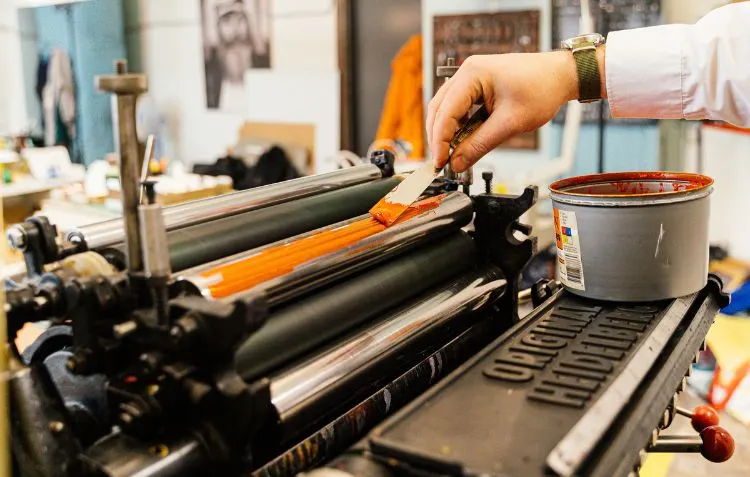Want to Start a Small Printing Business in 2025? Here’s How!
Despite the digital age’s rapid advancement, the demand for printing services remains robust and continues to grow. For those looking to start a small printing business, this presents a lucrative opportunity. The global commercial printing market is projected to expand from $339.57 billion in 2024 to $357.8 billion in 2025, reflecting a compound annual growth rate (CAGR) of 5.4%. (Source: Printing Market 2024 – Industry Analysis And Size)
Several sectors are fueling this growth. Custom apparel, for instance, has seen a surge in popularity, with businesses and individuals seeking personalized clothing items. Business branding materials, such as brochures and business cards, remain essential for companies aiming to establish a professional image. Additionally, personalized gifts have become a significant market segment, with consumers looking for unique, customized items for their loved ones.
Technological advancements have also played a pivotal role in making printing businesses both profitable and scalable. Innovations like eco-friendly inks and direct-to-film printing have not only improved the quality of printed materials but have also addressed environmental concerns, attracting a more eco-conscious clientele.
Key Takeaways: A Quick Overview
Starting a printing business can be a profitable venture if approached strategically. Here’s a snapshot of what you need to know:
- Market Research is Essential – Identify local and online demand, analyze competitors, and choose a profitable niche like custom T-shirts or business branding.
- A Solid Business Plan Sets the Foundation – Define your business model (home-based or commercial), calculate startup costs, and ensure legal compliance.
- Invest in the Right Equipment & Software – Choose suitable printers (DTG, sublimation, laser), heat presses, and design tools like Adobe Illustrator or Canva.
- Branding & Marketing Drive Sales – Build an online presence, optimize for SEO, leverage social media (Instagram, Pinterest), and use Google Ads for visibility.
- Competitive Pricing & Quality Service Matter – Implement tiered pricing, focus on bulk orders, and maintain high customer service standards.
- Scaling Up is the Path to Long-Term Success – Expand offerings (stickers, eco-friendly prints), explore e-commerce platforms, and consider B2B bulk services.
By following these steps, you can turn your printing business into a sustainable and profitable venture.
Market Research: Is There a Demand for Printing Services in Your Area?
Before investing in a printing business, understanding the market demand is essential. Identifying the right audience, analyzing competitors, and selecting a profitable niche can determine long-term success.
Identifying Your Target Market
The demand for printing services remains strong despite digital advancements. Common customers include:
- Local businesses – Need business cards, brochures, and banners.
- Event organizers – Require invitations, posters, and promotional materials.
- Schools and universities – Print yearbooks, certificates, and uniforms.
- Individuals – Seek custom gifts like T-shirts, mugs, and photo prints.
Online vs. Offline Demand
While traditional print shops serve local clients, e-commerce-based printing services are growing rapidly. Personalized print-on-demand products (e.g., Etsy, Shopify stores) cater to a global audience.
Competitor Analysis
Use tools like Google Trends to gauge keyword popularity in your area. Check local business directories and platforms like Statista for market insights.
Choosing a Profitable Niche
Specializing in a niche improves profitability. Popular niches in 2025 include:
- Custom T-shirts and apparel – Growing demand due to influencer culture.
- Eco-friendly printing – Businesses are shifting to sustainable materials.
- 3D printing – A rising trend in personalized manufacturing.
Supporting Data & Trends
A 2024 IBISWorld report shows the US printing industry generates over $70 billion annually. Niche markets like custom T-shirt printing are expected to grow by 9% by 2027, driven by e-commerce.
Creating a Business Plan: Your Roadmap to Success
A solid business plan helps turn your printing idea into a profitable venture. It defines objectives, financial strategies, and operational details.
Why a Business Plan Matters
Having a clear business plan increases your chances of securing funding, managing risks, and making informed decisions.
Key Components of Your Business Plan
1. Business Model: Brick-and-Mortar vs. Online
- Physical store – Ideal for local customers but has higher rent and operational costs.
- Online business – Lower overhead costs, can serve global customers via e-commerce platforms like Etsy or Shopify.
2. Financial Planning: Understanding Costs & Profitability
- Startup costs: Expect to invest between $5,000 to $50,000 depending on the scale.
- Pricing strategy: Balance affordability with profit margins.
- Ongoing expenses: Include materials, marketing, and labor costs.
3. Legal Requirements
- Business registration – LLC, sole proprietorship, or corporation.
- Licenses & permits – Varies by location (printing permits, resale certificates).
- Tax registration – EIN (US), VAT registration (UK, EU), ABN (Australia).
4. Equipment & Supply Chain Strategy
- Partner with reliable wholesale suppliers to cut costs.
- Consider dropshipping for online orders to minimize inventory risks.
Supporting Data & Trends
A 2025 comparison by Entrepreneur.com highlights that home-based print shops require $5,000–$15,000 in startup costs, while commercial print shops need over $50,000. Governments in the US, UK, Canada, and Australia offer small business grants to support startups.
Choosing the Right Printing Equipment & Software

The right equipment determines the quality, efficiency, and profitability of your printing business.
Essential Equipment for a Small Printing Business
1. Printers
- Direct-to-Garment (DTG) – Ideal for T-shirts and fabrics.
- Sublimation Printers – Best for mugs, phone cases, and polyester fabrics.
- Laser & Inkjet Printers – Suited for business cards, flyers, and labels.
2. Additional Tools
- Heat press machines – Required for sublimation and vinyl prints.
- Cutting machines – Essential for stickers, decals, and intricate designs.
- Screen printing kits – Suitable for large batch production.
Software for Designing & Workflow Automation
- Adobe Illustrator & CorelDRAW – Industry-standard design tools.
- Canva – User-friendly, cost-effective alternative.
- Printavo & DecoNetwork – Order and production management tools.
Cost-Effective vs. High-End Options
- Entry-level setup (~$5,000) – Ideal for home businesses (basic printers, heat press, and Canva).
- Mid-range setup (~$15,000) – Includes DTG printers, screen printing kits, and professional software.
- High-end setup ($50,000+) – Suitable for large-scale production.
Where to Buy?
- Trusted suppliers – Epson, Brother, Roland, and HP.
- Second-hand options – Facebook Marketplace, Craigslist, or specialized resellers.
Supporting Data & Trends
A 2025 report by PrintWeek shows sublimation printing is expected to grow 13% annually, making it one of the best investments.
Setting Up Your Printing Workspace
An efficient workspace ensures smooth operations, whether home-based or a retail location.
Home-Based vs. Retail Store: Pros & Cons
- Home-based – Lower costs, but limited production capacity.
- Retail shop – Higher visibility, better customer interaction, but increased expenses.
Space Management & Ventilation Needs
- Sublimation and DTG printers need proper ventilation to avoid ink fumes buildup.
- Screen printing requires a dedicated area for drying and ink handling.
Budget-Friendly Setup Tips
- Start with multi-functional equipment to save space.
- Use modular storage for materials like vinyl sheets and ink cartridges.
Branding & Marketing: How to Attract Customers
A strong brand and marketing strategy are crucial for attracting and retaining customers.
Building an Online Presence
- Website & SEO – Optimize for “small printing business” and local keywords.
- Google My Business – Essential for local visibility.
Social Media Marketing Strategies
- Instagram & Pinterest – Show off designs and customer testimonials.
- TikTok & YouTube – Create short videos demonstrating printing techniques.
Partnering with Local Businesses
- Offer discounted bulk printing for local companies.
- Collaborate with wedding planners, event organizers, and schools.
Paid Advertising & Promotions
- Google & Facebook Ads – Target businesses and event planners.
- Loyalty Programs – Offer repeat customers discounts or free upgrades.
Supporting Data & Trends
A HubSpot 2025 report found that 80% of customers prefer businesses with strong online reviews.
Pricing Strategy: How to Stay Competitive & Profitable
Setting the right prices in the printing business is key to staying competitive while ensuring profitability. Balancing material costs, labor, and market trends helps establish a sustainable pricing model.
Factors Influencing Pricing
- Material Costs: Ink, paper quality, and specialty finishes affect pricing.
- Labor & Overhead: Wages, equipment maintenance, and operational expenses must be factored in.
- Competitor Rates: Analyzing market prices helps maintain a competitive edge without undercutting profitability.
Tiered Pricing Strategies for Bulk Orders
Offering discounts for larger orders encourages higher sales volume. A tiered structure (e.g., 10% off for 100+ units) attracts business clients while preserving margins.
Importance of Upselling
Upselling premium paper, specialty finishes, or add-on services (e.g., custom designs) increases average order value.
Supporting Data & Trends
- The average profit margin in the printing industry ranges from 30-50%, depending on materials and services.
- Case Study: A small print shop increased revenue by 25% by introducing premium pricing on specialty prints.
Managing Orders & Customer Service Excellence

Efficient order management and exceptional customer service drive repeat business and positive word-of-mouth referrals.
Best Practices for Handling Orders Efficiently
- Use automated order management systems to track progress and deadlines.
- Keep inventory stocked to avoid delays.
- Clearly communicate order timelines with customers.
Managing Bulk Orders & Meeting Deadlines
- Batch processing minimizes downtime.
- Prioritize jobs based on urgency and volume.
- Invest in high-capacity printers to handle large orders efficiently.
Ensuring High Customer Satisfaction
- Clear communication: Provide accurate quotes and timelines.
- Transparency: Offer real-time order tracking and updates.
- Responsive Support: Quick resolution of inquiries builds trust.
Importance of Quality Checks Before Delivery
- Conduct final inspections to ensure prints meet client expectations.
- Implement a checklist system for consistency and quality control.
Scaling Your Business: Growth Strategies for Long-Term Success
Scaling a printing business requires strategic expansion into new products, platforms, and markets while maintaining quality and efficiency.
Expanding Product Lines
- Introduce custom stickers, 3D printing, and eco-friendly materials to cater to evolving customer preferences.
- Offer personalized prints (e.g., wedding invites, business branding kits) to attract niche markets.
Exploring E-Commerce Platforms
- Selling on Etsy, Shopify, and Amazon Handmade broadens customer reach.
- Optimizing product listings with SEO-driven descriptions increases visibility.
Offering B2B Bulk Services
- Partnering with local businesses for bulk corporate printing ensures steady revenue.
- Providing subscription-based printing (e.g., monthly flyers) locks in long-term clients.
Outsourcing vs. In-House Production
- Outsourcing can reduce costs but may compromise quality control.
- In-house production ensures consistency but requires investment in advanced printing equipment.
Supporting Data & Trends
- The global custom printing market is projected to reach $50 billion by 2030.
- Example: A small print shop scaled by expanding into merchandise printing, increasing revenue by 40%.
Common Mistakes to Avoid When Starting a Printing Business
Avoiding common pitfalls can prevent costly setbacks and improve long-term success in the printing industry.
Lack of Proper Research & Planning
- Failing to analyze market demand and competition can lead to poor positioning.
- A detailed business plan ensures strategic growth and financial stability.
Underestimating Startup Costs
- Printing equipment, materials, and software can be expensive.
- Budgeting for unexpected costs prevents financial strain.
Poor Quality Control & Customer Service
- Delivering subpar prints damages reputation and causes refund requests.
- Implementing strict quality assurance protocols enhances customer trust.
Ignoring Digital Marketing & SEO
- Lack of online presence limits customer reach.
- Investing in Google Ads, social media marketing, and SEO-optimized content drives traffic and sales.
Final Thoughts
Starting a successful printing business requires strategic planning, quality service, and effective marketing.
By understanding pricing strategies, mastering order management, and leveraging growth opportunities, entrepreneurs can establish a profitable venture. Avoiding common mistakes and prioritizing customer satisfaction helps build a loyal customer base.
With dedication and the right strategies, a printing business can evolve into a sustainable and thriving enterprise. Whether offering custom prints, bulk B2B services, or e-commerce solutions, there are limitless opportunities in the printing industry.
Are you ready to turn your passion into profit? Start planning today and build a business that stands out!
FAQs
What initial investment is required to start a small printing business?
The startup cost varies based on the printing niche and equipment quality. For instance, a basic home-based setup with a standard printer and design software may require a modest investment, while a commercial setup with advanced machinery can be significantly higher.
Do I need formal training to operate printing equipment?
While formal training isn’t mandatory, understanding your equipment and software is crucial. Many manufacturers offer tutorials, and online courses can enhance your proficiency. Hands-on practice will help you produce high-quality prints.
How can I find clients for my printing business?
Begin by networking within your local community. Attend events, join business associations, and leverage social media platforms to showcase your work. Offering promotions or discounts to first-time customers can also attract clientele.
What types of printing services are most profitable?
Profitability depends on market demand and specialization. Services like custom T-shirt printing, promotional items, and business branding materials often have high demand. Research your target market to identify the most lucrative opportunities.
How do I ensure the quality of my printed products?
Invest in reliable equipment and high-quality materials. Regular maintenance of your machines and staying updated with printing techniques will help maintain product quality. Additionally, implementing a thorough quality control process before delivery ensures customer satisfaction.







